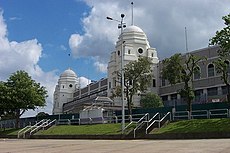
Back ملعب ويمبلي (1923) Arabic Stadion Wémbley (1923) BAN Уембли (1923) Bulgarian Stadion Wembley (1923) BS Wembley Stadium (1923) Catalan Wembley Stadium (1923) Czech Stadiwm Wembley (1923) Welsh Wembley Stadium (1923) Danish Wembley-Stadion (1923) German Estadio de Wembley (1923) Spanish
 | |
 The Twin Towers of Wembley Stadium (2002) | |
 | |
| Former names | Empire Stadium British Empire Exhibition Stadium |
|---|---|
| Location | Wembley, England |
| Coordinates | 51°33′20″N 0°16′47″W / 51.55556°N 0.27972°W |
| Owner | Wembley Company |
| Capacity | 82,000 (original standing capacity was 125,000, and later 100,000 prior to being made all-seated in 1990) |
| Record attendance | 126,047 (Bolton Wanderers vs West Ham United – 1923 FA Cup final) |
| Surface | Grass and track |
| Construction | |
| Broke ground | 1922 |
| Opened | 28 April 1923 |
| Renovated | 1963 |
| Closed | 7 October 2000 |
| Demolished | 2002–2003 |
| Rebuilt | Replaced in 2007 by the new Wembley Stadium |
| Construction cost | £750,000 (£49.81 million in 2023) |
| Architect | Sir John William Simpson and Maxwell Ayrton Sir Owen Williams (engineer) |
| Tenants | |
| England national football team (1923–2000) Wembley Lions speedway team (1946–1957, 1970–1971) Wales national rugby union team (1997–1999) Arsenal (UEFA matches, 1998–2000) London Monarchs (1991–1992) Leyton Orient FC (1930) Argonauts (1928–1930)[1] | |
The former Wembley Stadium (/ˈwɛmbli/; originally known as the Empire Stadium) was a football stadium in Wembley, London, best known for hosting important football matches. It stood on the same site now occupied by its successor and by its predecessor, Watkin's Tower.
Wembley hosted the FA Cup final annually, the first in 1923, which was the stadium's inaugural event, the League Cup final annually, five European Cup finals, the 1966 World Cup final, and the final of Euro 1996. Brazilian footballer Pelé once said of the stadium: "Wembley is the cathedral of football. It is the capital of football and it is the heart of football",[2] in recognition of its status as the world's most famous football stadium.
The stadium also hosted many other sports events, including the 1948 Summer Olympics, rugby league's Challenge Cup final, and the 1992 and 1995 Rugby League World Cup finals. It was also the venue for numerous music events, including the 1985 Live Aid charity concert. In what was the first major WWF (now WWE) pay-per-view to take place outside North America, it hosted the 1992 SummerSlam.
- ^ Twydell, Dave (5 November 2001). Denied F.C.: The Football League Election Struggles. Harefield: Yore Publications. pp. 30–31. ISBN 1-85983-512-0.
- ^ "Mayor of London – Case for Wembley Stadium". Archived from the original on 30 March 2006.